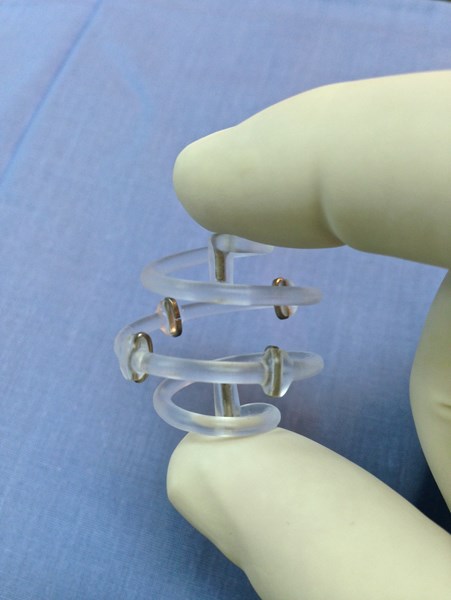ALEXANDRIA, Va., Oct. 27, 2015 (GLOBE NEWSWIRE) -- A local surgeon is among the first in Virginia and metropolitan D.C. to adopt an innovative new device that improves the treatment of breast cancer, by more precisely targeting radiation treatment and providing for better follow-up exams.
Dr. David Weintritt of the National Breast Center has helped pioneer use of the BioZorb™ marker, which is placed during lumpectomy surgery performed to remove the cancer as part of breast conservation therapy.
The unique three-dimensional marker is the first device that identifies in a fixed, 3D manner where the tumor was removed. It helps the radiation oncologist more reliably determine where to aim the radiation.
The marker consists of a spiral made of a bioabsorbable material that holds six titanium clips. The spiral slowly dissolves in the body over the course of a year or more. The tiny marker clips stay in place so the surgical site can be viewed for long-term monitoring.
"One reason this new marker is a great advance is that it allows us to more accurately locate the area where the tumor was removed," said Dr. Weintritt. "As a breast surgeon, I don't have to try to describe to the radiation treatment planners where the tumor was located. The marker is sutured right to the site and shows the radiation oncologist exactly where to focus the beam. Put another way, we can precisely target the cells we need to treat, without endangering healthy ones during radiation therapy."
Breast cancer can be treated by mastectomy (breast removal) or by lumpectomy. With lumpectomy, a small amount of tissue containing the tumor is removed. In addition to the surgery, radiation treatment is typically added to "clean up" any microscopic cancer cells that might remain behind in the breast.
Prior to development of the marker, radiation treatments usually had to be directed at a larger portion of the breast tissue. While this approach is proven to reduce the risk of recurrence, it can also expose healthy tissues to radiation.
"This new device helps us to locate the breast cancer site and see it in three dimensions," said Jane Grayson, M.D., a radiation oncologist who treats many of Dr. Weintritt's patients after surgery. "Identifying the surgical cavity is especially important for women who have chemotherapy before their radiation treatment, when time and healing can obscure the lumpectomy site."
Among local patients who have benefited from the BioZorb device is Janis Monk, 53, an attorney with a federal government agency. In 2014, an abnormality was detected by a routine mammogram. Monk's gynecologist referred her to Dr. Weintritt for her breast cancer surgery. The operation was challenging from a cosmetic standpoint, because of the tumor's location close to the skin.
"There is a question about whether the body will completely fill in the space during the healing process," said Dr. Weintritt. "The BioZorb device can help overcome this problem by serving as a structure for new tissue to build around. That is exactly what happened for Janis, leading to a very satisfying cosmetic outcome."
Dr. Weintritt said that during the healing process, the device seems to act as a framework that can also help to retain the natural shape of the breast.
"While my primary concern was to come out of this experience with my health intact, a secondary concern was to have as intact an appearance as medically possible, Monk said. "The BioZorb sounded like a good method to assist with all of my concerns. I couldn't be happier with my outcome. Doctors and nurses have told me that, without seeing my medical charts, they would not have detected the surgery."
Dr. Weintritt said he's especially pleased with how the 3D marker fits with newer breast reconstruction techniques such as oncoplastic surgery, which combines plastic surgery methods and breast surgery.
"Oncoplastic surgery has been a great advance in our field, but it also creates issues about how to accurately mark the surgical site for radiation therapy," he said. "The marker helps eliminate those challenges, because it shows us exactly where the surgical site is even when oncoplastic surgery has been performed in that area."
About the National Breast Center and National Breast Center Foundation
Dr. Weintritt founded the National Breast Center and National Breast Center Foundation, in Alexandria. The National Breast Center offers a comprehensive program for early detection, diagnosis, and treatment of breast cancer, as well as services for those at high risk for breast cancer. Combining advanced technology with superior medical and surgical care, the centers' medical staff evaluates and treats both benign and malignant breast diseases. For more information visit www.nationalbreastcenter.com.
The National Breast Center Foundation was created to make an impact against breast cancer by providing access to care, incorporating new technology, and educating patients about all the options available to them. Too many women either can't get the care they need or aren't aware of options that would be helpful to treat their cancer. For more information email dweintritt@nationalbreastcenter.com.
A photo accompanying this release is available at:
http://www.globenewswire.com/newsroom/prs/?pkgid=37150
